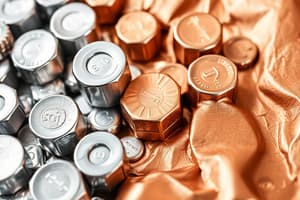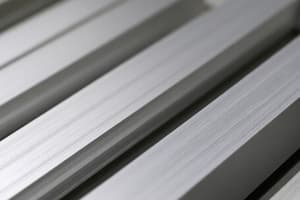Podcast
Questions and Answers
What happens to chromium in the presence of atmospheric oxygen?
What happens to chromium in the presence of atmospheric oxygen?
- It forms hydrogen gas
- It gets partly or wholly oxidized to the tervalent state (correct)
- It renders chromium passive
- It dissolves readily in hot, concentrated H2SO4
Which type of ions does chromium form in aqueous solutions?
Which type of ions does chromium form in aqueous solutions?
- Cr2+ cations and chromate (CrO4) 2- anions only
- Cr3+ and dichromate anions only
- Cr2+, Cr3+ cations, and chromate (CrO4) 2- anions (correct)
- Cr2+ and Cr3+ cations only
Which ion complex is present in the 'green' solutions of chromium (III)?
Which ion complex is present in the 'green' solutions of chromium (III)?
- [Cr(H2O)4OH]3-
- [Cr(H2O)5CI]2+ (correct)
- [Cr(H2O)4C12] +
- [Cr(H2O)6]
Why are Cr2+ ions rarely encountered in inorganic qualitative analysis?
Why are Cr2+ ions rarely encountered in inorganic qualitative analysis?
What is the color of the solutions where the hexaquochromate (III) ion is present?
What is the color of the solutions where the hexaquochromate (III) ion is present?
How does dilute sulfuric acid react with chromium?
How does dilute sulfuric acid react with chromium?
What happens when aluminum objects are exposed to air?
What happens when aluminum objects are exposed to air?
How does concentrated HCl react with aluminum?
How does concentrated HCl react with aluminum?
What is the valence of chromium in chromic compounds?
What is the valence of chromium in chromic compounds?
Which statement about aluminum sulfide is correct?
Which statement about aluminum sulfide is correct?
What is the effect of adding some mercury (II) chloride to the mixture of aluminum and acid?
What is the effect of adding some mercury (II) chloride to the mixture of aluminum and acid?
Which compound is formed when Manganese reacts with warm water?
Which compound is formed when Manganese reacts with warm water?
What happens when hot, concentrated H2SO4 attacks Manganese?
What happens when hot, concentrated H2SO4 attacks Manganese?
Which characteristic describes chromium (Cr3+)?
Which characteristic describes chromium (Cr3+)?
Which color do the Mn(II) salts appear to be in solutions?
Which color do the Mn(II) salts appear to be in solutions?
What type of ions does aluminum form with alkali hydroxides?
What type of ions does aluminum form with alkali hydroxides?
How many oxides of manganese are known?
How many oxides of manganese are known?
What do Mn(II) cations derive from?
What do Mn(II) cations derive from?
Which statement about manganese compounds is correct?
Which statement about manganese compounds is correct?
What is the correct statement about zinc's physical properties?
What is the correct statement about zinc's physical properties?
Which statement about zinc's reactivity with acids is incorrect?
Which statement about zinc's reactivity with acids is incorrect?
What happens when zinc reacts with hot, concentrated H2SO4?
What happens when zinc reacts with hot, concentrated H2SO4?
Which statement about zinc's reaction with alkalis is correct?
Which statement about zinc's reaction with alkalis is correct?
What are the applications of metallic zinc mentioned in the text?
What are the applications of metallic zinc mentioned in the text?
Flashcards are hidden until you start studying
Study Notes
Chromium and Its Behavior
- Chromium reacts with atmospheric oxygen, forming a protective oxide layer which inhibits further oxidation.
- In aqueous solutions, chromium forms Cr³⁺ and Cr²⁺ ions, with Cr³⁺ being more stable.
- The 'green' solutions of chromium (III) contain the hexaquochromate (III) ion, [Cr(H₂O)₆]³⁺.
- Cr²⁺ ions are rarely observed in inorganic qualitative analysis due to their instability and tendency to oxidize to Cr³⁺.
Chromium Solutions and Reactions
- Hexaquochromate (III) solutions exhibit a green color.
- When treated with dilute sulfuric acid, chromium can be oxidized to higher oxidation states.
Aluminum and Its Reactions
- When exposed to air, aluminum forms a protective oxide layer that prevents further corrosion.
- Concentrated HCl reacts with aluminum, generating hydrogen gas and forming aluminum chloride.
- The valence of chromium in chromic compounds is +3.
Aluminum Compounds and Reactions
- Aluminum sulfide (Al₂S₃) is known to release hydrogen sulfide gas upon reaction with moisture.
- Adding mercury (II) chloride to a mixture of aluminum and acid leads to the formation of elemental mercury and aluminum chloride.
Manganese and Its Compounds
- When manganese reacts with warm water, manganese(II) hydroxide is formed.
- Hot, concentrated H₂SO₄ reacts with manganese, leading to the formation of manganese sulfate and release of sulfur dioxide.
- Characteristics of Cr³⁺ include being a hydrated ion that imparts a distinct color to solutions.
- Mn(II) salts appear pale pink in solutions.
Aluminum and Manganese Reactions
- Aluminum forms aluminate ions with alkali hydroxides.
- There are seven known oxides of manganese, including MnO and MnO₂.
- Mn(II) cations derive from oxidation states of manganese when reacting with acids.
Miscellaneous Compounds and Zinc Properties
- Manganese compounds exhibit various oxidation states and reactivity patterns.
- Zinc has a low melting point and high electrical conductivity.
- An incorrect statement about zinc's reactivity with acids is often misconstrued; zinc reacts effectively with dilute acids but less so with concentrated ones.
- When zinc reacts with hot, concentrated H₂SO₄, hydrogen gas is released, and zinc sulfate forms.
- Zinc reacts with alkalis to form zincates, exhibiting amphoteric behavior.
Applications of Zinc
- Zinc is utilized in galvanization, making alloys, and as a dietary supplement due to its essential role in human health.
Studying That Suits You
Use AI to generate personalized quizzes and flashcards to suit your learning preferences.





